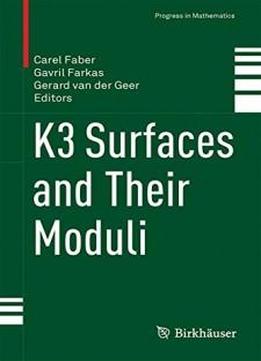
K3 Surfaces And Their Moduli (progress In Mathematics)
by Carel Faber /
2016 / English / PDF
4.1 MB Download
This book provides an overview of the latest developments
concerning the moduli of K3 surfaces. It is aimed at algebraic
geometers, but is also of interest to number theorists and
theoretical physicists, and continues the tradition of related
volumes like “The Moduli Space of Curves” and “Moduli of Abelian
Varieties,” which originated from conferences on the islands
Texel and Schiermonnikoog and which have become classics.
This book provides an overview of the latest developments
concerning the moduli of K3 surfaces. It is aimed at algebraic
geometers, but is also of interest to number theorists and
theoretical physicists, and continues the tradition of related
volumes like “The Moduli Space of Curves” and “Moduli of Abelian
Varieties,” which originated from conferences on the islands
Texel and Schiermonnikoog and which have become classics.
K3 surfaces and their moduli form a central topic in algebraic
geometry and arithmetic geometry, and have recently attracted a
lot of attention from both mathematicians and theoretical
physicists. Advances in this field often result from mixing
sophisticated techniques from algebraic geometry, lattice theory,
number theory, and dynamical systems. The topic has received
significant impetus due to recent breakthroughs on the Tate
conjecture, the study of stability conditions and derived
categories, and links with mirror symmetry and string theory. At
the same time, the theory of irreducible holomorphic symplectic
varieties, the higher dimensional analogues of K3 surfaces, has
become a mainstream topic in algebraic geometry.
K3 surfaces and their moduli form a central topic in algebraic
geometry and arithmetic geometry, and have recently attracted a
lot of attention from both mathematicians and theoretical
physicists. Advances in this field often result from mixing
sophisticated techniques from algebraic geometry, lattice theory,
number theory, and dynamical systems. The topic has received
significant impetus due to recent breakthroughs on the Tate
conjecture, the study of stability conditions and derived
categories, and links with mirror symmetry and string theory. At
the same time, the theory of irreducible holomorphic symplectic
varieties, the higher dimensional analogues of K3 surfaces, has
become a mainstream topic in algebraic geometry.
Contributors: S. Boissière, A. Cattaneo, I. Dolgachev, V.
Gritsenko, B. Hassett, G. Heckman, K. Hulek, S. Katz, A. Klemm,
S. Kondo, C. Liedtke, D. Matsushita, M. Nieper-Wisskirchen, G.
Oberdieck, K. Oguiso, R. Pandharipande, S. Rieken, A. Sarti,
I. Shimada, R. P. Thomas, Y. Tschinkel, A. Verra, C. Voisin.
Contributors: S. Boissière, A. Cattaneo, I. Dolgachev, V.
Gritsenko, B. Hassett, G. Heckman, K. Hulek, S. Katz, A. Klemm,
S. Kondo, C. Liedtke, D. Matsushita, M. Nieper-Wisskirchen, G.
Oberdieck, K. Oguiso, R. Pandharipande, S. Rieken, A. Sarti,
I. Shimada, R. P. Thomas, Y. Tschinkel, A. Verra, C. Voisin.











